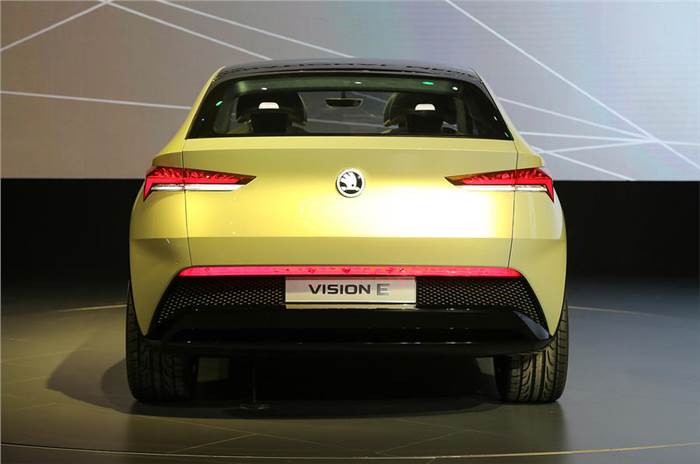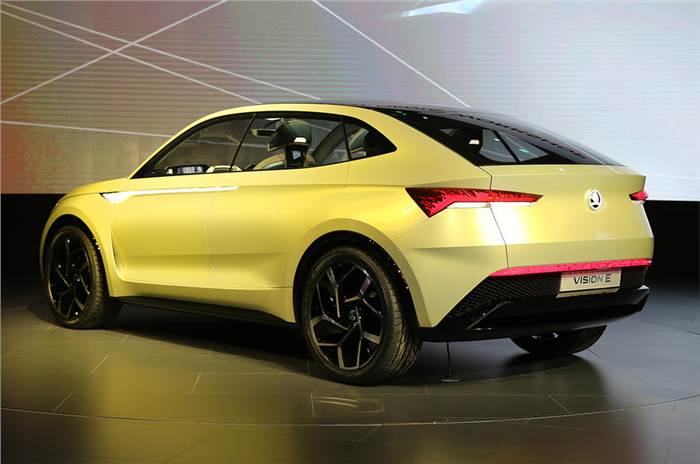The striking Skoda Vision E electric car concept has been revealed ahead of its Shanghai motor show debut. The 304hp production version of Skoda’s electric-powered crossover is predicted to hit 100kph from rest in just six seconds, about 0.5sec faster than an Octavia vRS hot hatch.
Significant for being the first Skoda concept powered by a battery-electric drivetrain, the Vision E is also a “very good guide” to a 2020 production electric crossover and sets out the Czech company’s electrification strategy, which promises five fully-electric cars by 2025. The first electrified Skoda will be a plug-in hybrid version of the Superb launched in 2019. "By 2025, one in every four cars sold by Skoda worldwide should be a plug-in hybrid or have a purely electric drive," says the company.
Designed in the Czech Republic, the Vision E possesses purposeful proportions with tight front and rear overhangs, a pleasing sweeping roofline and strongly expressed feature lines. It sits on 2,851mm wheelbase, 60mm longer than Skoda’s new Kodiaq SUV and 10mm longer than the Superb saloon. It takes advantage of the floor-mounted battery and compact motors and drive components of the MEB electric car platform, which allows Skoda’s designers to push the front bulkhead farther forward than in an internal-combustion engine car.
Skoda says, there is “seven per cent more internal space” — a reference to the longer interior — and a seating position “25 per cent higher” — a reference to the mildly-raised crossover roofline. Luggage space is described as roomier than usual. At 1,591mm high, the Vision E is also about two-thirds the height between the Kodiaq and the Superb, giving it tall car, crossover proportions.
The body features a generous hatchback opening, which further emphasises the Vision E’s practicality. Skoda refers to the roofline as ‘coupe-like’ and it does curve gracefully front to rear as it subsides towards the rear lamps.
To emphasise interior space, Skoda has designed ‘clamshell-style’ doors in which the back pair hinges rearwards to give access to the cabin unhindered by a central pillar. A favourite of concept designs, it is most likely that the production car will feature a central pillar to ensure adequate side-impact safety.
Like all electric cars, there is no need for a conventional grille capable of flowing cooling air to a radiator. Instead, designers now have the freedom to create a new front face using shaped sheet metal and lighting, which Skoda’s designers have dubbed a ‘phantom grille’ that appears as if it is present, but in reality isn’t.
Trapezoidal front LED lamps are pushed to the extremities of the front face and are linked by an illuminated bar fashioned from crystal glass, one of the Czech Republic’s most famous exports.
Inside, Skoda’s designers have also penned a new look taking advantage of the flat-floor body architecture, which emphasises spaciousness.
A major change compared to an internal combustion engine car is the absence of a gearshift, a freedom that interior designer Peter Olah describes as ‘paradise in design’.
Olah’s interiors feature a sweeping dashboard centred on a 12-inch touchscreen, centrally mounted and arranged in conventional ‘landscape’ format, rather than Tesla and Volvo’s more contemporary ‘portrait’ orientation.
New to Skoda is a dashboard architecture designed with a prominent step to allow the driver to steady his/her hand as functions are selected on the move. Full width across the dashboard is soft mood lighting, configurable in different hues.
In front of the driver is a two-spoke, multi-function wheel and a second flat screen for basic driving functions.
Two lithium-ion battery packs are being engineered for the Vision E and its VW Group platform twins – either an 80kW or a 50kW – are expected to be offered as individual models just as different engine capacities make up a car range today. These battery packs can then be combined with a choice of two motor outputs – 175kW (237hp) on the rear axle and 50kW (68hp) on the front axle.
The motor power is rated in total at 305hp, but is split between two motors. It is assumed that one will power the front axle and the other the rear axle, but again, these details haven’t yet been released.
Skoda claims acceleration up to the car's top speed of 180kph is “particularly smooth and dynamic”. Skoda sources say that the maximum performance combination will still offer a 500km range, although a 237hp two-wheel drive Vision E equipped with a 80kW battery is tipped to offer an even longer range.
The production version of the Vision E goes on sale in 2020, although it is likely that the model range will be phased-in over 18 months.






Comments
Member Login
Personal Details
No comments yet. Be the first to comment.